clock BUICK ENCLAVE 2009 Owner's Manual
[x] Cancel search | Manufacturer: BUICK, Model Year: 2009, Model line: ENCLAVE, Model: BUICK ENCLAVE 2009Pages: 412
Page 116 of 412

Cargo Management
System
This vehicle has one of these cargo
management systems located in
the rear of the vehicle.
To open, pull the handle toward the
rear of the vehicle and lift the
cover up.
There is an additional storage
compartment on each side of the
system. To open, unlatch and lift the
panel up.To remove the cargo management
system:
1. Open the cover. It remains open
when lifted.
2. Remove the side panels and
place inside.
3. Loosen the retaining nuts on
each side of the system by
turning them counterclockwise.
4. Close the cover.
5. Pull up on the system by using
the built in handles and remove
it from the vehicle.To remove the cargo management
cover:{CAUTION
An improperly latched and closed
cargo cover, or cargo cover left in
the open position, could be
thrown about the vehicle during a
collision or sudden maneuver.
Someone could be injured. Be
sure to return the cover to the
closed position and latch before
driving. If the cover is removed,
always store it outside of the
vehicle. When it is replaced,
always be sure that it is securely
reattached.
1. Open the cover. It remains open
when lifted.
2. Pull the cover up making sure to
unhook the hinges at the rear of
the cover.
3. Remove the cover from the
vehicle and store outside of
the vehicle. Cargo Management System with
a Removable Storage Area
Cargo Management System with
a Removable Cover
2-52 Features and Controls
Page 119 of 412
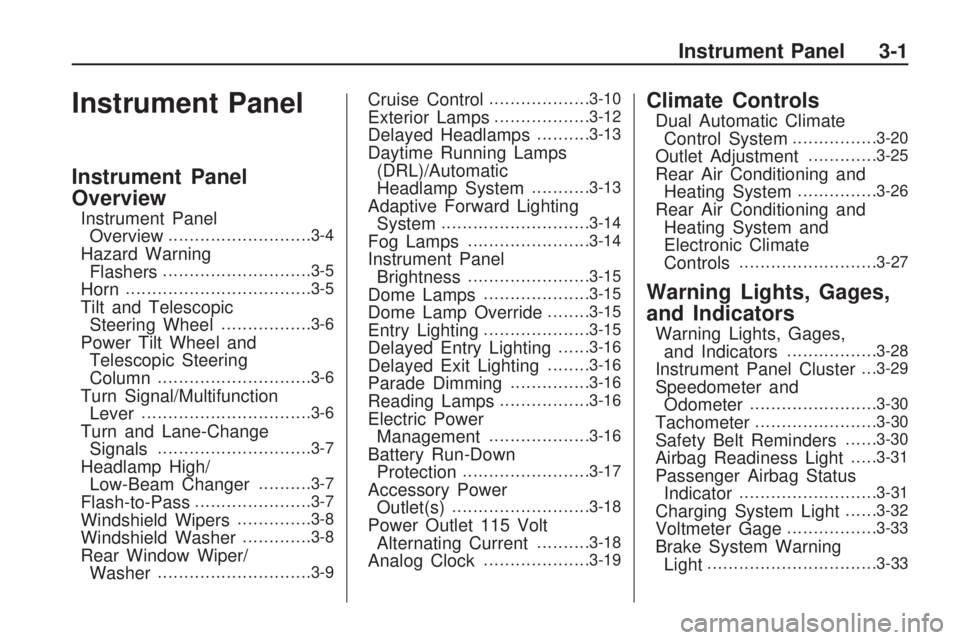
Instrument Panel
Instrument Panel
Overview
Instrument Panel
Overview...........................3-4
Hazard Warning
Flashers............................3-5
Horn...................................3-5
Tilt and Telescopic
Steering Wheel.................3-6
Power Tilt Wheel and
Telescopic Steering
Column
.............................3-6
Turn Signal/Multifunction
Lever................................3-6
Turn and Lane-Change
Signals.............................3-7
Headlamp High/
Low-Beam Changer..........3-7
Flash-to-Pass......................3-7
Windshield Wipers..............3-8
Windshield Washer.............3-8
Rear Window Wiper/
Washer.............................3-9
Cruise Control...................3-10
Exterior Lamps..................3-12
Delayed Headlamps..........3-13
Daytime Running Lamps
(DRL)/Automatic
Headlamp System
...........3-13
Adaptive Forward Lighting
System............................3-14
Fog Lamps.......................3-14
Instrument Panel
Brightness.......................3-15
Dome Lamps....................3-15
Dome Lamp Override........3-15
Entry Lighting....................3-15
Delayed Entry Lighting......3-16
Delayed Exit Lighting........3-16
Parade Dimming...............3-16
Reading Lamps.................3-16
Electric Power
Management...................3-16
Battery Run-Down
Protection........................3-17
Accessory Power
Outlet(s)..........................3-18
Power Outlet 115 Volt
Alternating Current..........3-18
Analog Clock....................3-19
Climate Controls
Dual Automatic Climate
Control System................3-20
Outlet Adjustment.............3-25
Rear Air Conditioning and
Heating System...............3-26
Rear Air Conditioning and
Heating System and
Electronic Climate
Controls
..........................3-27
Warning Lights, Gages,
and Indicators
Warning Lights, Gages,
and Indicators.................3-28
Instrument Panel Cluster. . .3-29
Speedometer and
Odometer........................3-30
Tachometer.......................3-30
Safety Belt Reminders......3-30
Airbag Readiness Light.....3-31
Passenger Airbag Status
Indicator..........................3-31
Charging System Light......3-32
Voltmeter Gage.................3-33
Brake System Warning
Light................................3-33
Instrument Panel 3-1
Page 120 of 412
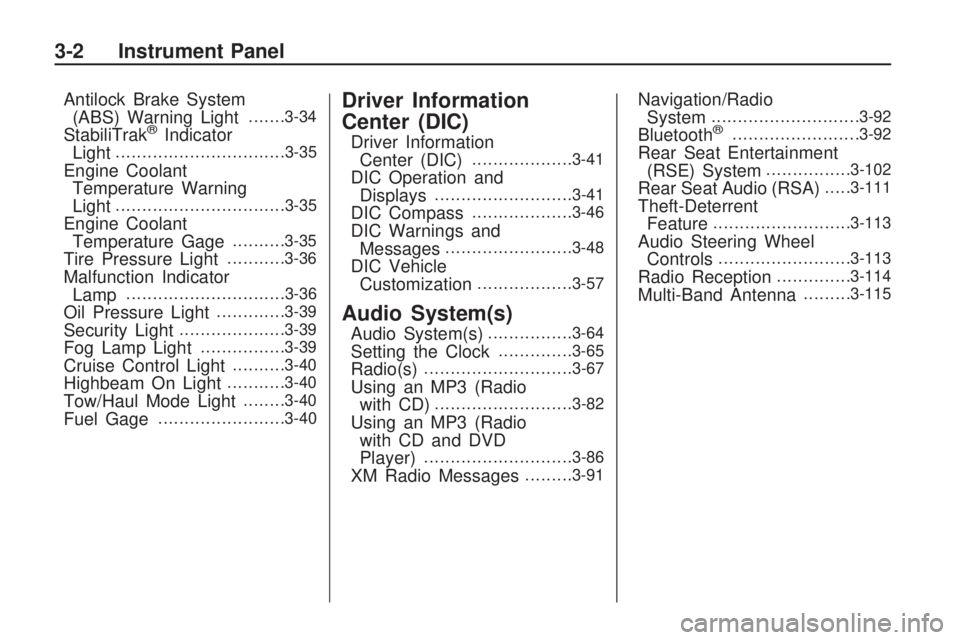
Antilock Brake System
(ABS) Warning Light.......3-34
StabiliTrak®Indicator
Light................................3-35
Engine Coolant
Temperature Warning
Light
................................3-35
Engine Coolant
Temperature Gage..........3-35
Tire Pressure Light...........3-36
Malfunction Indicator
Lamp..............................3-36
Oil Pressure Light.............3-39
Security Light....................3-39
Fog Lamp Light................3-39
Cruise Control Light..........3-40
Highbeam On Light...........3-40
Tow/Haul Mode Light........3-40
Fuel Gage........................3-40
Driver Information
Center (DIC)
Driver Information
Center (DIC)...................3-41
DIC Operation and
Displays..........................3-41
DIC Compass...................3-46
DIC Warnings and
Messages........................3-48
DIC Vehicle
Customization..................3-57
Audio System(s)
Audio System(s)................3-64
Setting the Clock..............3-65
Radio(s)............................3-67
Using an MP3 (Radio
with CD)..........................3-82
Using an MP3 (Radio
with CD and DVD
Player)
............................3-86
XM Radio Messages.........3-91
Navigation/Radio
System............................3-92
Bluetooth®........................3-92
Rear Seat Entertainment
(RSE) System................3-102
Rear Seat Audio (RSA).....3-111
Theft-Deterrent
Feature..........................3-113
Audio Steering Wheel
Controls.........................3-113
Radio Reception..............3-114
Multi-Band Antenna.........3-115
3-2 Instrument Panel
Page 123 of 412

The main components of your
instrument panel are listed here:
A.Outlet Adjustment on page 3-25.
B.Turn Signal/Multifunction
Lever on page 3-6.Windshield
Wipers on page 3-8.
C.Instrument Panel Cluster on
page 3-29.
D.Driver Information Center (DIC)
on page 3-41.
E.Analog Clock on page 3-19.
F.Audio System(s) on page 3-64.
Navigation/Radio System on
page 3-92(If Equipped).
G.Exterior Lamps on page 3-12.
Fog Lamps on page 3-14.
H.Hood Release on page 5-9.
I.Dome Lamp Override on
page 3-15.Instrument Panel
Brightness on page 3-15. Heated
Windshield Washer Button
(If Equipped). SeeWindshield
Washer on page 3-8.J.Cruise Control on page 3-10.
K.Tilt and Telescopic Steering
Wheel on page 3-6.
L.Horn on page 3-5.
M.Audio Steering Wheel Controls
on page 3-113.
N.Hazard Warning Flashers on
page 3-5.
O.Dual Automatic Climate Control
System on page 3-20.
P. Center Console Shift Lever. See
“Console Shift Lever” under
Shifting Into Park on page 2-28.
Q.Rear Window Wiper/Washer on
page 3-9. Traction Control
System (TCS) Disable Button
(If Equipped). SeeStabiliTrak
®
System on page 4-5.Tow/Haul
Mode on page 2-26(If
Equipped).Power Liftgate on
page 2-10(If Equipped).
R.Accessory Power Outlet(s) on
page 3-18.
S.Heated Seats on page 1-4.T. Passenger Air Bag Status
Indicator. SeePassenger
Sensing System on page 1-52.
U.Glove Box on page 2-49.
Hazard Warning Flashers
|
Hazard Warning
Flasher:Press this button located
on the instrument panel below
the audio system, to make the front
and rear turn signal lamps �ash
on and off. This warns others that
you are having trouble. Press
again to turn the �ashers off.
The turn signals do not work while
the hazard warning �ashers are on.
Horn
Press near or on the horn symbols
on the steering wheel pad to
sound the horn.
Instrument Panel 3-5
Page 133 of 412

Instrument Panel
Brightness
D
(Instrument Panel
Brightness):The knob with this
symbol on it is located next to
the exterior lamps control to the left
of the steering wheel. Push the
knob in all the way until it extends
out and then turn the knob clockwise
or counterclockwise to brighten or
dim the lights. Push the knob
back in when �nished.
Dome Lamps
The dome lamps automatically
come on when a door is opened,
unless the dome lamp override
button is pressed in.
The lamps can also be turned on
and off by turning the instrument
panel brightness control clockwise to
the farthest position.
Dome Lamp Override
The dome lamp override button
is located next to the exterior lamps
control.
The dome lamp override sets the
dome lamps to remain off or
come on automatically when a door
is opened.
E(Dome Lamp Override):Press
the button in and the dome lamps
remain off when a door is opened.
Press the button again to return it to
the extended position so that the
dome lamps come on when a door
is opened.
Entry Lighting
For vehicles with courtesy lamps,
they come on and stay on for a set
time whenever the unlock symbol
is pressed on the Remote Keyless
Entry (RKE) Transmitter, if the
vehicle has one.If a door is opened, the lamps stay
on while it is open and then turn
off automatically about 25 seconds
after the door is closed. If the
unlock symbol is pressed and no
door is opened, the lamps turn
off after about 20 seconds.
Entry lighting includes a feature
called theater dimming. With theater
dimming, the lamps do not turn off at
the end of the delay time. Instead,
they slowly dim after the delay time
until they go out. The delay time is
canceled if the ignition key is turned
to ON/RUN or the power door lock
switch is pressed. The lamps will dim
right away.
When the ignition is on, illuminated
entry is inactive, which means
the courtesy lamps will not come on
unless a door is opened.
Instrument Panel 3-15
Page 137 of 412
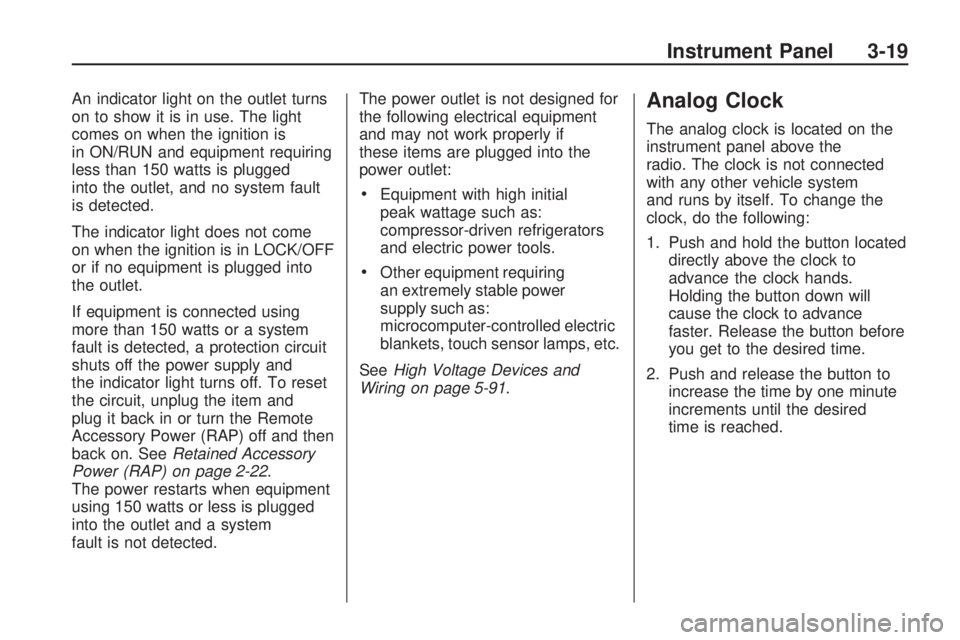
An indicator light on the outlet turns
on to show it is in use. The light
comes on when the ignition is
in ON/RUN and equipment requiring
less than 150 watts is plugged
into the outlet, and no system fault
is detected.
The indicator light does not come
on when the ignition is in LOCK/OFF
or if no equipment is plugged into
the outlet.
If equipment is connected using
more than 150 watts or a system
fault is detected, a protection circuit
shuts off the power supply and
the indicator light turns off. To reset
the circuit, unplug the item and
plug it back in or turn the Remote
Accessory Power (RAP) off and then
back on. SeeRetained Accessory
Power (RAP) on page 2-22.
The power restarts when equipment
using 150 watts or less is plugged
into the outlet and a system
fault is not detected.The power outlet is not designed for
the following electrical equipment
and may not work properly if
these items are plugged into the
power outlet:
Equipment with high initial
peak wattage such as:
compressor-driven refrigerators
and electric power tools.
Other equipment requiring
an extremely stable power
supply such as:
microcomputer-controlled electric
blankets, touch sensor lamps, etc.
SeeHigh Voltage Devices and
Wiring on page 5-91.
Analog Clock
The analog clock is located on the
instrument panel above the
radio. The clock is not connected
with any other vehicle system
and runs by itself. To change the
clock, do the following:
1. Push and hold the button located
directly above the clock to
advance the clock hands.
Holding the button down will
cause the clock to advance
faster. Release the button before
you get to the desired time.
2. Push and release the button to
increase the time by one minute
increments until the desired
time is reached.
Instrument Panel 3-19
Page 144 of 412

Rear Air Conditioning and Heating System
A. Fan Control
B. Temperature Control
C. Air Delivery Mode Control
For vehicles with the rear climate
control system, the controls
are located on the rear of the center
console. The system can also be
controlled with the front controls.
Press the REAR button on the front
climate control system to turn the
rear climate control system on or off.An indicator comes on when the
rear system is on. The system also
turns on if any of the rear controls
are adjusted.
Mimic Mode:
This mode matches
the rear climate control to the
front climate control settings. It
comes on when REAR is pressed.
Independent Mode: This mode
directs rear seating air�ow according
to the settings of the rear controls. It comes on when any rear control
is adjusted.
Fan Control:
Turn clockwise or
counterclockwise to increase
or decrease the fan speed. Turn the
knob to
9to turn the fan off.
Temperature Control: Turn
clockwise or counterclockwise to
increase or decrease the air�ow
temperature.
Air Delivery Mode Control: Turn
to the desired mode to change
the air�ow direction.
H(Vent): Air is directed through
the overhead outlets.
)(Bi-Level): Air is directed
through the rear �oor outlets, as
well as the overhead outlets.
6(Floor): Air is directed through
the �oor outlets. The rear system
�oor outlets are located under
the third row seats.
3-26 Instrument Panel
Page 183 of 412
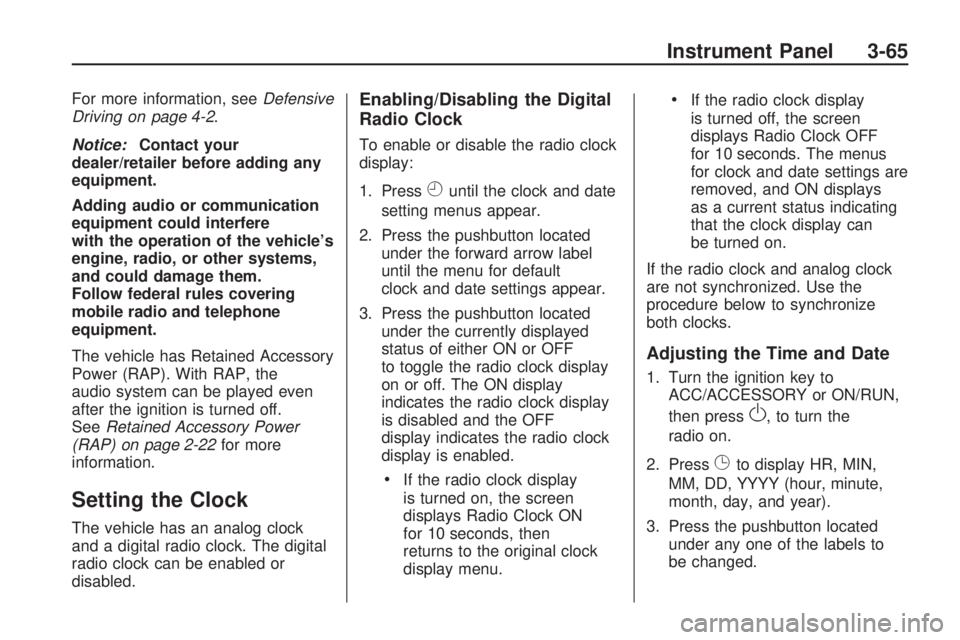
For more information, seeDefensive
Driving on page 4-2.
Notice:Contact your
dealer/retailer before adding any
equipment.
Adding audio or communication
equipment could interfere
with the operation of the vehicle’s
engine, radio, or other systems,
and could damage them.
Follow federal rules covering
mobile radio and telephone
equipment.
The vehicle has Retained Accessory
Power (RAP). With RAP, the
audio system can be played even
after the ignition is turned off.
SeeRetained Accessory Power
(RAP) on page 2-22for more
information.
Setting the Clock
The vehicle has an analog clock
and a digital radio clock. The digital
radio clock can be enabled or
disabled.
Enabling/Disabling the Digital
Radio Clock
To enable or disable the radio clock
display:
1. Press
Huntil the clock and date
setting menus appear.
2. Press the pushbutton located
under the forward arrow label
until the menu for default
clock and date settings appear.
3. Press the pushbutton located
under the currently displayed
status of either ON or OFF
to toggle the radio clock display
on or off. The ON display
indicates the radio clock display
is disabled and the OFF
display indicates the radio clock
display is enabled.
If the radio clock display
is turned on, the screen
displays Radio Clock ON
for 10 seconds, then
returns to the original clock
display menu.
If the radio clock display
is turned off, the screen
displays Radio Clock OFF
for 10 seconds. The menus
for clock and date settings are
removed, and ON displays
as a current status indicating
that the clock display can
be turned on.
If the radio clock and analog clock
are not synchronized. Use the
procedure below to synchronize
both clocks.
Adjusting the Time and Date
1. Turn the ignition key to
ACC/ACCESSORY or ON/RUN,
then press
O, to turn the
radio on.
2. Press
Gto display HR, MIN,
MM, DD, YYYY (hour, minute,
month, day, and year).
3. Press the pushbutton located
under any one of the labels to
be changed.
Instrument Panel 3-65
Page 184 of 412
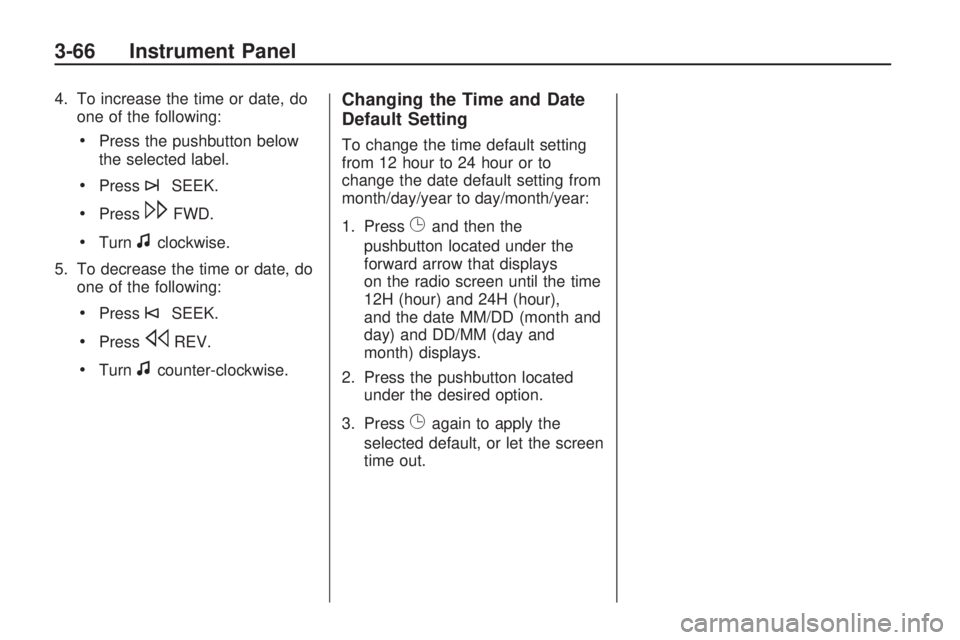
4. To increase the time or date, do
one of the following:
Press the pushbutton below
the selected label.
Press¨SEEK.
Press\FWD.
Turnfclockwise.
5. To decrease the time or date, do
one of the following:
Press©SEEK.
PresssREV.
Turnfcounter-clockwise.
Changing the Time and Date
Default Setting
To change the time default setting
from 12 hour to 24 hour or to
change the date default setting from
month/day/year to day/month/year:
1. Press
Gand then the
pushbutton located under the
forward arrow that displays
on the radio screen until the time
12H (hour) and 24H (hour),
and the date MM/DD (month and
day) and DD/MM (day and
month) displays.
2. Press the pushbutton located
under the desired option.
3. Press
Gagain to apply the
selected default, or let the screen
time out.
3-66 Instrument Panel
Page 187 of 412
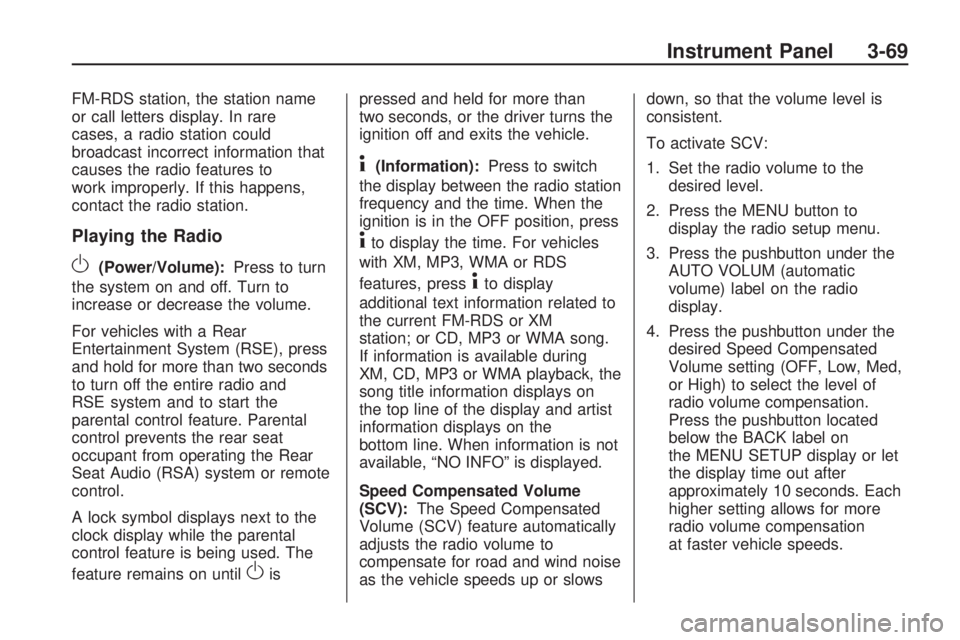
FM-RDS station, the station name
or call letters display. In rare
cases, a radio station could
broadcast incorrect information that
causes the radio features to
work improperly. If this happens,
contact the radio station.
Playing the Radio
O(Power/Volume):Press to turn
the system on and off. Turn to
increase or decrease the volume.
For vehicles with a Rear
Entertainment System (RSE), press
and hold for more than two seconds
to turn off the entire radio and
RSE system and to start the
parental control feature. Parental
control prevents the rear seat
occupant from operating the Rear
Seat Audio (RSA) system or remote
control.
A lock symbol displays next to the
clock display while the parental
control feature is being used. The
feature remains on until
Oispressed and held for more than
two seconds, or the driver turns the
ignition off and exits the vehicle.
4(Information):Press to switch
the display between the radio station
frequency and the time. When the
ignition is in the OFF position, press
4to display the time. For vehicles
with XM, MP3, WMA or RDS
features, press
4to display
additional text information related to
the current FM-RDS or XM
station; or CD, MP3 or WMA song.
If information is available during
XM, CD, MP3 or WMA playback, the
song title information displays on
the top line of the display and artist
information displays on the
bottom line. When information is not
available, “NO INFO” is displayed.
Speed Compensated Volume
(SCV):The Speed Compensated
Volume (SCV) feature automatically
adjusts the radio volume to
compensate for road and wind noise
as the vehicle speeds up or slowsdown, so that the volume level is
consistent.
To activate SCV:
1. Set the radio volume to the
desired level.
2. Press the MENU button to
display the radio setup menu.
3. Press the pushbutton under the
AUTO VOLUM (automatic
volume) label on the radio
display.
4. Press the pushbutton under the
desired Speed Compensated
Volume setting (OFF, Low, Med,
or High) to select the level of
radio volume compensation.
Press the pushbutton located
below the BACK label on
the MENU SETUP display or let
the display time out after
approximately 10 seconds. Each
higher setting allows for more
radio volume compensation
at faster vehicle speeds.
Instrument Panel 3-69